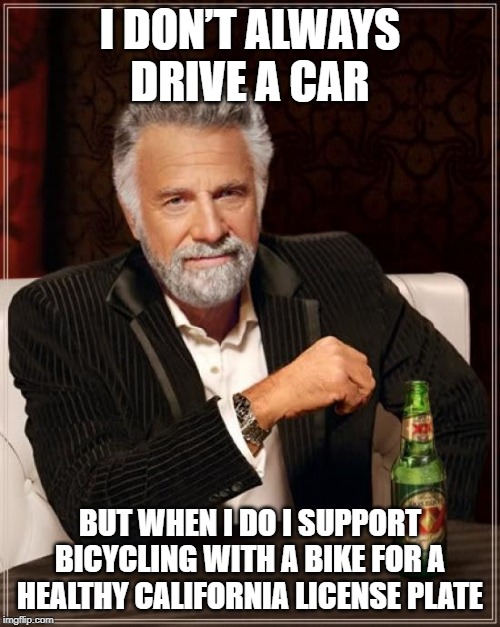DISCOVER YOUR LOCAL BICYCLING COMMUNITY
Find local advocacy groups, bike shops, instructors, clubs, classes and more!
Drivers have more than one way to show support for biking
 Nothing feels more a like a double-cross than when a driver passes you too close and their car ends up having a bike rack on it. There are other ways, too, for bicyclists to spot drivers whose other vehicle is a bike or who support safer roads for people who bike and walk. When League Cycling Instructors host “Bicycle Friendly Driver” classes, graduates get stickers with which they can proudly adorn their car. And in 26 states, specialty license plates support state programs, non-profits, and events that promote bicycling. California – a state where both car and bicycle culture abounds – will join these states if 7,500 people pre-order the Bike for a Healthy California plate.
Nothing feels more a like a double-cross than when a driver passes you too close and their car ends up having a bike rack on it. There are other ways, too, for bicyclists to spot drivers whose other vehicle is a bike or who support safer roads for people who bike and walk. When League Cycling Instructors host “Bicycle Friendly Driver” classes, graduates get stickers with which they can proudly adorn their car. And in 26 states, specialty license plates support state programs, non-profits, and events that promote bicycling. California – a state where both car and bicycle culture abounds – will join these states if 7,500 people pre-order the Bike for a Healthy California plate.
For years, all states had one license plate design that was used for all cars. In 1976, states began to issue specialty license plates commemorating the United States’ bicentennial. In the last two decades, these specialty license plate programs have exploded in popularity – with some states offering hundreds of options. As specialty license plates have become a staple of car culture, they have increasingly allowed people who bike, or care about biking, to support people who bike through a specialty license plate.
This year, Arizona and California are, hopefully, joining the 26 states that currently offer support for bicycling through a specialty license plate.
- In Arizona, their “share the road” license plate will provide 50% of its revenues to an Arizona-based 501(c)(3) organization that “promotes safety and awareness in the cycling community” and 50% to an Arizona-based 501(c)(3) organization that “offers the opportunity for a person to use a loaner bicycle if the person is registered in a charity cycling event and is not able to afford to purchase a bicycle.”
- In California, the Bike for a Healthy California license plate will create a grant program to “promote cycling as a physical activity, fund bike skill development and nutrition education at the elementary school level and create safe places to ride through cycling advocacy.” Before this grant program can be created, 7,500 people must apply for the specialty license plate. This is like other states that have specialty license plates created through an administrative rather than legislative process.
[[{“fid”:”7363″,”view_mode”:”default”,”fields”:{“format”:”default”,”alignment”:””,”field_file_image_alt_text[und][0][value]”:false,”field_file_image_title_text[und][0][value]”:false,”field_author[und][0][value]”:””,”field_title[und][0][value]”:””},”link_text”:null,”type”:”media”,”field_deltas”:{“1”:{“format”:”default”,”alignment”:””,”field_file_image_alt_text[und][0][value]”:false,”field_file_image_title_text[und][0][value]”:false,”field_author[und][0][value]”:””,”field_title[und][0][value]”:””}},”attributes”:{“style”:”display: block; margin-left: auto; margin-right: auto;”,”class”:”media-element file-default”,”data-delta”:”1″}}]]
Are you interested in whether your state has a bike-supporting license plate? You can find that information in our Bike Law University series. Most states establish license plates through legislation and our resources show which organizations are supported by the plate in states where they have been established. We also included “share the road” license plates that do not directly benefit bicycling organizations but share similar phrasing and symbols with bike supporting license plates. Check out the article and chart that explains it all!